A Combined Barite–Ilmenite Weighting Material to Prevent Barite Sag in Water-Based Drilling Fluid
Abstract
:1. Introduction
2. Methodology
2.1. Materials
2.2. Static Sag Test
2.3. Dynamic Sag Test
- The sag shoe was put in the bottom of the cup and the drilling fluid sample (140 mL) was poured in the cup;
- The fluid sample was heated until 120 °F and a viscometer was run at 100 RPM;
- Then, a 10-mL sample was collected from the collection well in the bottom of the sag shoe using a syringe with a cannula, and the weight was recorded (W1);
- After 30 min, the viscometer was stopped, and another sample was taken from the bottom and weighted (W2);
- The dynamic sag factor (VSST) was calculated in ppg using Equation (2).
2.4. Measurements of Rheology and Viscoelastic Properties
2.5. HPHT Filtration Test
3. Results and Discussion
4. Conclusions
- As the concentration of ilmenite was increased, the final density of the drilling fluid increased because of the high density of ilmenite, while the pH of the drilling fluid slightly decreased to reach 9.5 for 100 wt.% ilmenite. However, the pH value is still within the acceptable pH range (9–11) and it can be maintained by adding pH control additives.
- Adding ilmenite enhanced the stability of the drilling fluid and significantly reduced the sag factor for both static and dynamic conditions. The sag factor decreased as the concentration of ilmenite increased, and 50 wt.% ilmenite was adequate to prevent barite sag in both conditions. The sag factor dropped from 0.59 to 0.51 in static conditions, while VSST dropped from 1.75 to 0.33 in dynamic conditions.
- Ilmenite improved the rheology of the drilling fluid and maintained rheological properties under HPHT conditions. In contrast, a huge drop in rheological properties of the base fluid (without ilmenite) was observed because of the high temperature. Similarly, ilmenite enhanced the viscoelastic properties of the drilling fluid by increasing the elasticity of the drilling fluid, which validates the sag test results.
- From the HPHT filtration results, adding ilmenite to the base drilling fluid had no impact on the filtration performance and filter cake properties. The total filtrate volume was 6.2 cm3 for both fluids (100 wt.% barite and 50 wt.% ilmenite), while a 2.5-mm filter cake was formed in both cases.
- Based on the rheology and sag test results, 50 wt.% is the optimum concentration of ilmenite, and adding more than this concentration is not recommended as it would add more cost to the drilling operation.
- The combined barite–ilmenite weighting material could be a good option to safely kill or drill HPHT oil and gas wells with minimal sag tendency; however, more research work is needed to remove the composite filter cake in the case of drilling, because the removal process of the filter cake would be more complex as two different materials need to be dissolved. Therefore, a new approach to remove the composite filter cake is required.
Author Contributions
Funding
Acknowledgments
Conflicts of Interest
References
- Li, M.C.; Wu, Q.; Song, K.; French, A.D.; Mei, C.; Lei, T. pH-Responsive Water-Based Drilling Fluids Containing Bentonite and Chitin Nanocrystals. ACS Sustain. Chem. Eng. 2018, 6, 3783–3795. [Google Scholar] [CrossRef]
- Li, M.C.; Ren, S.; Zhang, X.; Dong, L.; Lei, T.; Lee, S.; Wu, Q. Surface-Chemistry-Tuned Cellulose Nanocrystals in a Bentonite Suspension for Water-Based Drilling Fluids. ACS Appl. Nano Mater. 2018, 1, 7039–7051. [Google Scholar] [CrossRef]
- Vryzasa, Z.; Nalbandiand, L.; Zaspalis, V.T.; Kelessidis, V.C. How different nanoparticles affect the rheological properties of aqueous Wyoming sodium bentonite suspensions. J. Pet. Sci. Eng. 2019, 173, 941–954. [Google Scholar] [CrossRef]
- Saboorian-Jooybari, H.; Dejam, M.; Chen, Z. Heavy oil polymer flooding from laboratory core floods to pilot tests and field applications: Half-century studies. J. Pet. Sci. Eng. 2016, 142, 85–100. [Google Scholar] [CrossRef]
- Mashayekhizadeh, V.; Kord, S.; Dejam, M. EOR potential within Iran. Spec. Top. Rev. Porous Media Int. J. 2014, 5, 325–354. [Google Scholar] [CrossRef]
- Amirian, E.; Dejam, M.; Chen, Z. Performance forecasting for polymer flooding in heavy oil reservoirs. Fuel 2018, 216, 83–100. [Google Scholar] [CrossRef]
- Mohamed, A.K.; Elkatatny, S.A.; Mahmoud, M.A.; Shawabkeh, R.A.; Al-Majed, A.A. The Evaluation of Micronized Barite as a Weighting Material for Completing HPHT Wells. In Proceedings of the SPE Middle East Oil & Gas Show and Conference, Manama, Bahrain, 6–9 March 2017. Paper SPE183768-MS. [Google Scholar]
- Bourgoyne, A.T.; Chenevert, M.E.; Millheim Keith, K.; Young, F.S. Applied Drilling Engineering. Soc. Pet. Eng. 1986, 2, 514. [Google Scholar]
- Omland, T.H.; Saasen, A.; Amund, P. Detection Techniques Determining Weighting Material Sag in Drilling Fluid and Relationship to Rheology. Ann. Trans. Nord. Soc. 2007, 15, 277. [Google Scholar]
- Hossain, M.E.; Al-Majed, A.A. Fundamentals of Sustainable Drilling Engineering; John Wiley & Sons: Hoboken, NJ, USA, 2015. [Google Scholar]
- Ba Geri, B.S.; Mahmoud, M.A.; Abdulraheem, A.; Al-Mutairi, S.H.; Shawabkeh, R.A. Single Stage Filter Cake Removal of Barite Weighted Water Based Drilling Fluid. J. Pet. Sci. Eng. 2016, 149, 476–484. [Google Scholar] [CrossRef]
- Sloan, J.P.; Brooks, J.P.; Dear, S.F., 3rd. A New, Nondamaging, Acid-Soluble Weighting Material. J. Pet. Technol. 1975, 15–20. [Google Scholar] [CrossRef]
- Tuntland, O.B. Iron oxide as Weight Materials for Drilling Muds. Erdoel/Erdgas Zeitschrif 1982, 97, 300–302. [Google Scholar]
- Walker, C.O. Alternative Weighting Material. J. Petrol. Technol. 1983, 35, 2158–2164. [Google Scholar] [CrossRef]
- Al-Yami, A.S.; Nasr-El-Din, H.A.; Al-Majed, A.A.; Menouar, H. An Innovative Manganese Tetra-Oxide/KCl Water-Based Drill-in Fluids for HT/HP Wells. In Proceedings of the SPE Annual Technical Conference and Exhibition, Anaheim, CA, USA, 11–14 November 2007; pp. 11–14. [Google Scholar]
- Al-Bagoury, M.; Steele, C.D. A New, Alternative Weight Material for Drilling Fluids. In Proceedings of the the IADC/SPE Drilling Conference and Exhibition, San Diego, CA, USA, 6–8 March 2012. Paper SPE 151331. [Google Scholar]
- Xiao, J.; Nasr-El-Din, H.A.; Al-Bagoury, M. Evaluation of Micronized Ilmenite as a Weighting Material in Oil-based Drilling Fluids for HPHT Applications. In Proceedings of the SPE European Formation Damage Conference and Exhibition, Noordwijk, The Netherlands, 5–7 June 2013. Paper SPE-165184. [Google Scholar]
- Tehrani, A.; Cliffe, A.; Hodder, M.H.; Young, S.; Lee, J.; Stark, J.; Seale, S. Alternative Drilling Fluid Weighting Agents: A Comprehensive Study on Ilmenite and Hematite. In Proceedings of the IADC/SPE Drilling Conference and Exhibition, Dallas, TX, USA, 4–6 March 2014. Paper IADC/SPE 167937. [Google Scholar]
- Caenn, R.; Darley, H.C.H.; Gray, G.R. Composition and Properties of Drilling and Completion Fluids, 6th ed.; Elsevier: Amsterdam, The Netherlands, 2011. [Google Scholar]
- Bern, P.A.; Oort, E.V.; Neustadt, B.; Ebeltoft, H.; Zurdo, C.; Zamora, M.; Slater, K.S. Barite Sag: Measurement, Modeling, and Management. SPE Drill. Complet. 2000, 15, 25–30. [Google Scholar] [CrossRef]
- Murphy, R.; Jamison, D.; Hemphill, T.; Bell, S.; Albrecht, C. Measuring and Predicting Dynamic Sag. SPE Drill. Complet. 2008, 23, 142–149. [Google Scholar] [CrossRef]
- Scott, P.D.; Zamora, M.; Aldea, C. Barite-Sag Management: Challenges, Strategies, Opportunities. In Proceedings of the IADC/SPE Drilling Conference, Dallas, TX, USA, 2–4 March 2004. Paper IADC/SPE 87136. [Google Scholar]
- Temple, C.; Paterson, F.; Leith, D. Method for Reducing Sag in Drilling, Completion and Workover Fluids. U.S. Patent 6,861,393, 1 March 2005. [Google Scholar]
- Alabdullatif, Z.; Al-yami, A.; Wagle, V.; Bubshait, A.; Al-safran, A. Development of New Kill Fluids with Minimum Sagging Problems for High Pressure Jilh Formation in Saudi Arabia. Saudi Aramco J. Technol. 2015. Available online: https://pdfs.semanticscholar.org/e36c/025ca72b5cc71c68ed8ff07a6106b12ae60e.pdf (accessed on 14 June 2019).
- Davis, L.; Lfvanec, W.; Shumway, W. Additive to Enhance Sag Stability of Drilling Fluid. U.S. Patent No. WO 2017/188946 Al, 2 November 2017. [Google Scholar]
- Elkatatny, S.M. Enhancing the Stability of Invert Emulsion Drilling Fluid for Drilling in High Pressure High-Temperature Conditions. Energies 2018, 11, 2393. [Google Scholar] [CrossRef]
- Basfar, S.; Elkatatny, S.; Mahmoud, M.; Kamal, M.S.; Murtaza, M.; Stanitzek, T. Prevention of Barite Sagging while Drilling High-Pressure High-Temperature (HPHT) Wells. In Proceedings of the SPE Kingdom of Saudi Arabia Annual Technical Symposium and Exhibition, Dammam, Saudi Arabia, 23–26 April 2018. Paper SPE-192198-MS. [Google Scholar]
- Elkatatny, S.M. Mitigation of barite sagging during the drilling of high-pressure high-temperature wells using an invert emulsion drilling fluid. Powder Technol. 2019, 352, 325–330. [Google Scholar] [CrossRef]
- Blomberg, N.; Melberg, B.; Boe, A.; Jacobsen, E.; Aarrestad, S. Evaluation of Ilmenite as Weight Material in Drilling Fluids. J. Petrol. Technol. 2007, 36, 969–974. [Google Scholar] [CrossRef]
- Haaland, E.; Pettersen, G.; Tuntland, O.B. Testing of Iron Oxides as Weight Materials for Drilling Muds. SPE J. 1976, 6218. Available online: https://www.onepetro.org/general/SPE-6218-MS (accessed on 14 June 2019).
- Elkatatny, S.M.; Nasr El-Din, H.A. Evaluation of Ilmenite as Weighting Material in Water-Based Drilling Fluids for HPHT Applications. In Proceedings of the SPE Kuwait International Petroleum Conference and Exhibition, Kuwait City, Kuwait, 10–12 December 2012. Paper SPE-163377. [Google Scholar]
- Abdou, M.I.; Al-Sabagh, A.M.; Ahmed, H.E.S.; Fadl, A.M. Impact of barite and ilmenite mixture on enhancing the drilling mud weight. Egypt. J. Pet. 2018, 27, 955–967. [Google Scholar] [CrossRef]
- Skalle, P.; Backe, K.R.; Lyomov, S.K.; Sveen, J. Barite Segregation in Inclined Boreholes. J. Can. Pet. Technol. 1999, 38, 1–6. [Google Scholar] [CrossRef]
- Maxey, J. Rheological Analysis of Static and Dynamic Sag in Drilling Fluids. Annu. Trans. Nord. Soc. 2007, 15, 181. [Google Scholar]
- Aldea, C.; Growcock, F.B.; Lee, L.J.; Friedheim, J.E.; Oort, E.V. Prevention of Dynamic Sag in Deepwater Invert Emulsion Fluids. In Proceedings of the AADE 2001 National Drilling Conference, ‘Drilling Technology’, Houston, TX, USA, 27–29 March 2001. [Google Scholar]
- Bern, P.A.; Zamora, M.; Hemphill, A.T.; Marshall, D.; Omland, T.H.; Morton, E. Field Monitoring of Weight-Material Sag. In Proceedings of the AADE Fluids Conference and Exhibition, Houston TX, USA, 6–7 April 2010. [Google Scholar]
- Power, D.; Zamora, M. Drilling Fluid Yield Stress: Measurement Techniques for Improved Understanding of Critical Drilling Fluid Parameters. In Proceedings of the AADE National Technology Conference, Houston, TX, USA, 1–3 April 2003. Paper AADE-03-NTCE-35. [Google Scholar]
- Chilingarian, G.; Alp, E.; Uslu, S.; Gonzales, S.; Ronald, J. Drilling Fluid Evaluation Using Yield Point-Plastic Viscosity Correlation. Energy Sour. 1986, 8, 233–244. [Google Scholar] [CrossRef]
- Bui, B.; Saasen, A.; Maxey, J.; Ozbayoglu, M.E.; Miska, S.Z.; Yu, M.; Takach, N.E. Viscoelastic Properties of Oil-Based Drilling fluids. Annu. Trans. Nord. Soc. 2012, 20, 33–47. [Google Scholar]
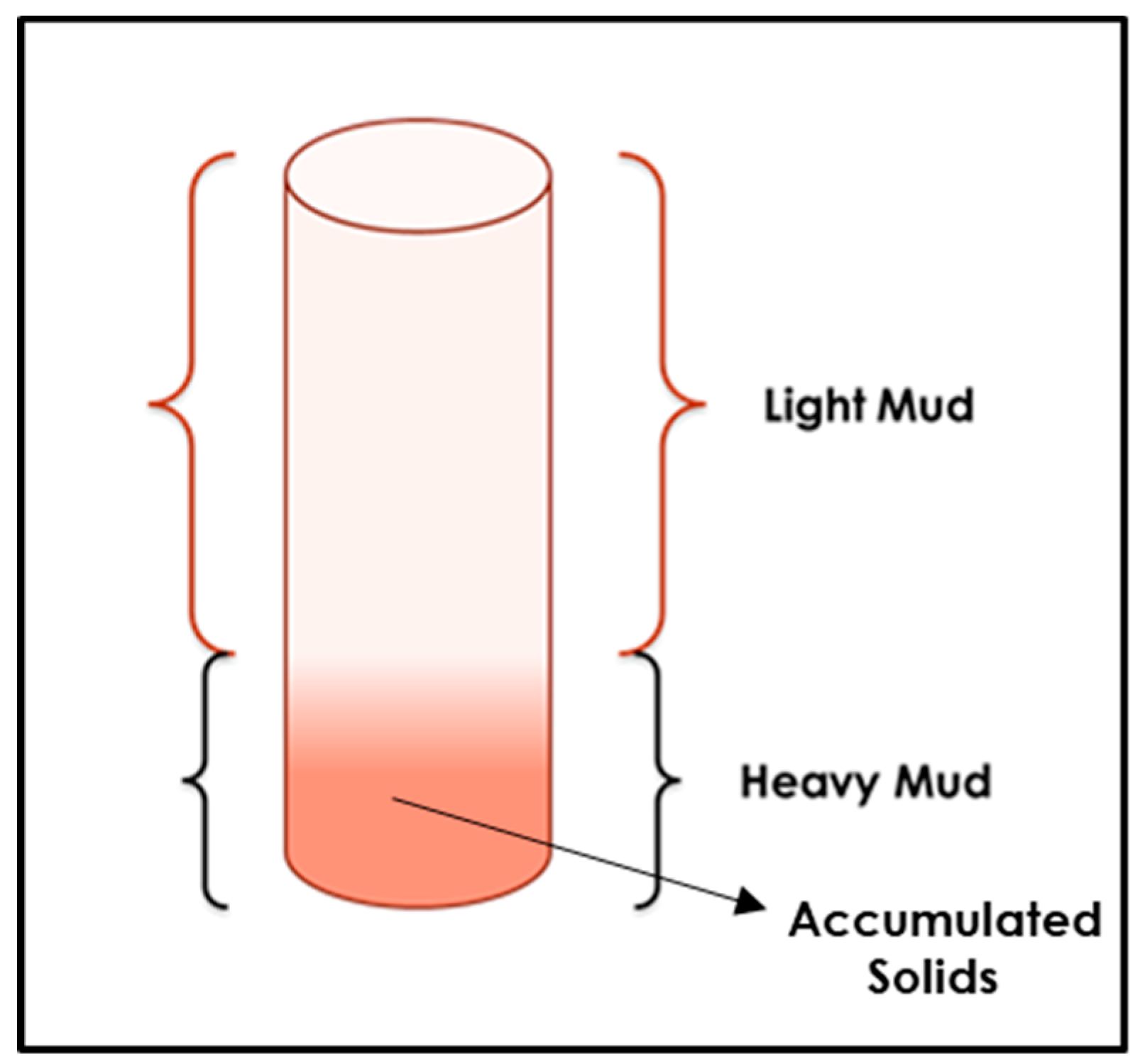
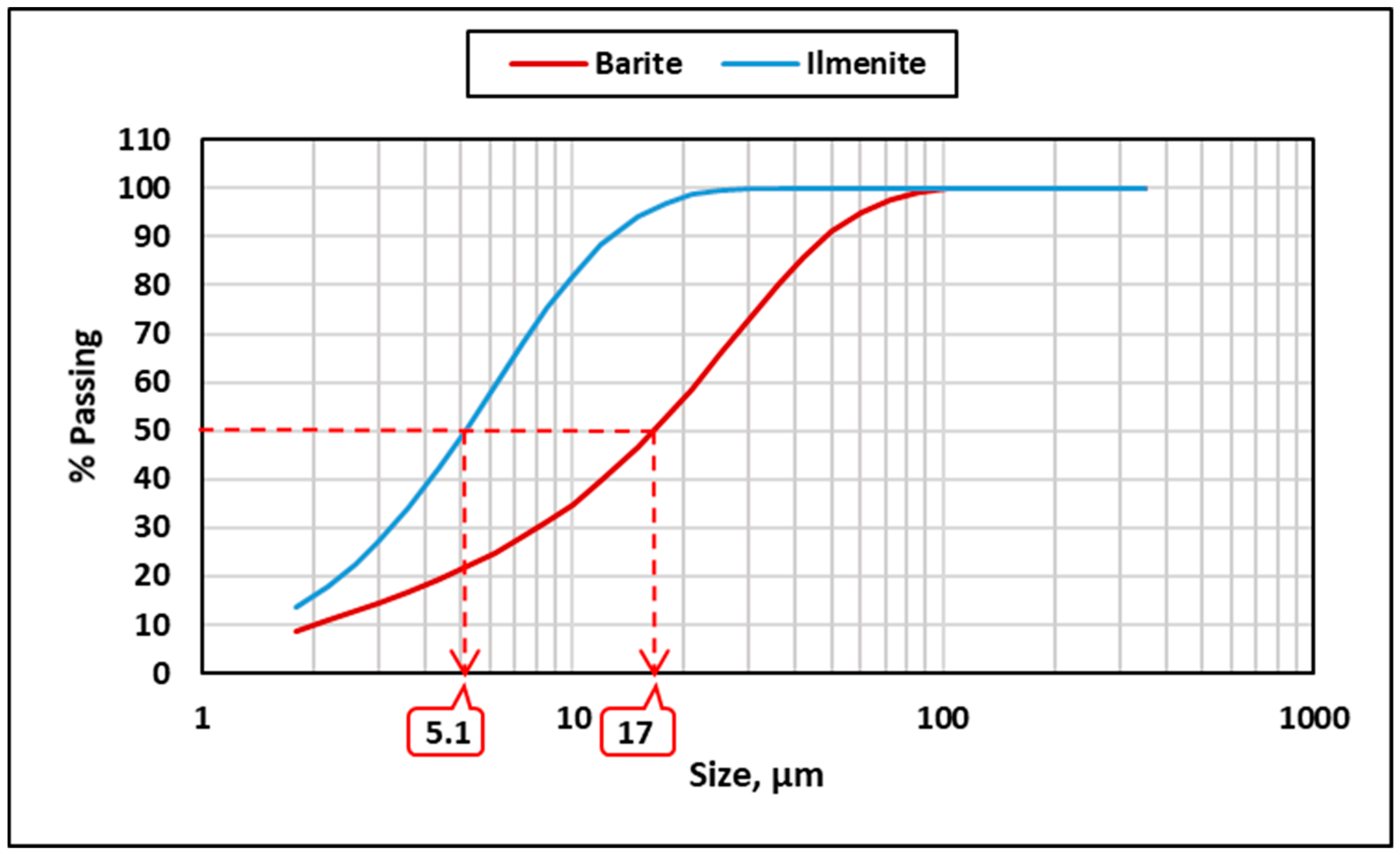
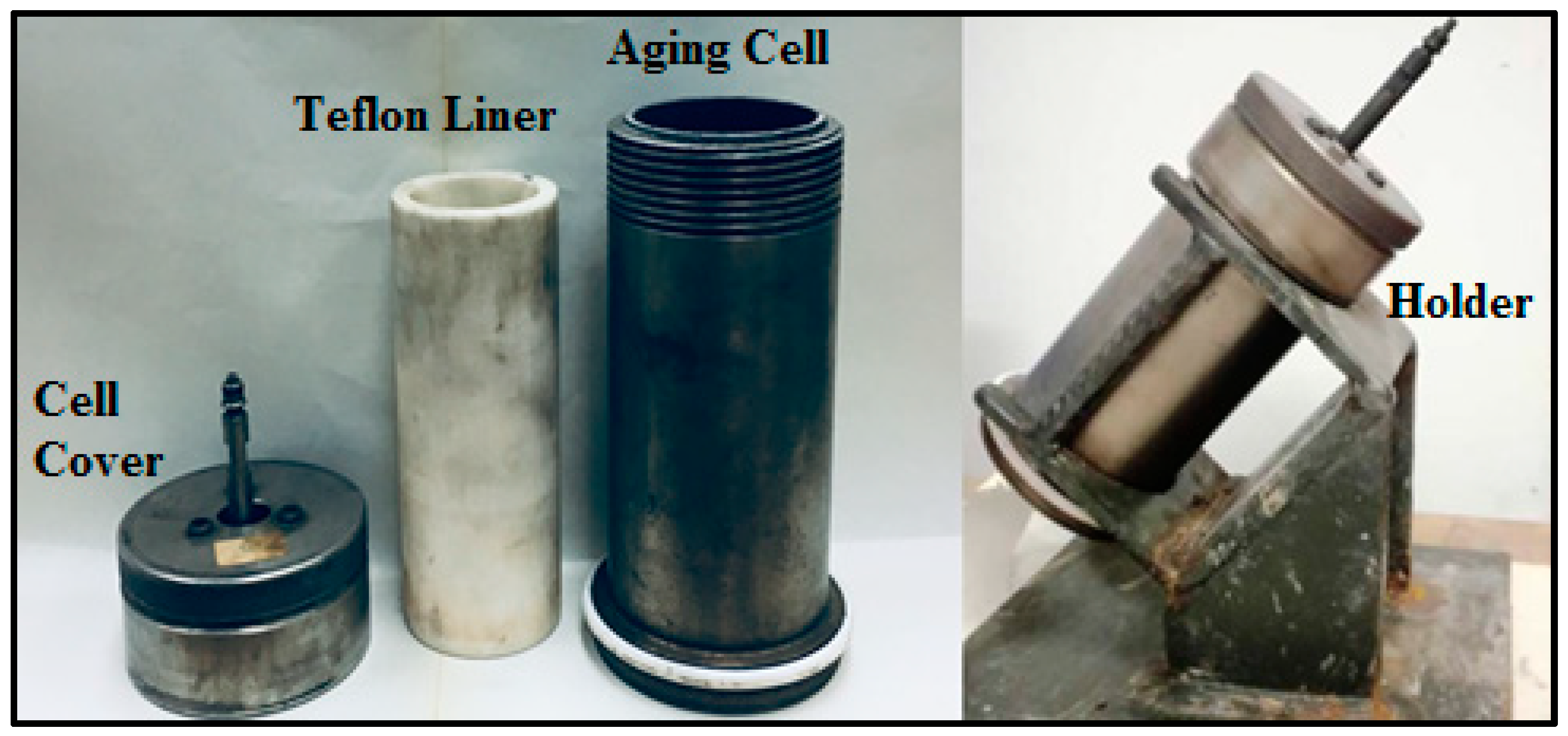
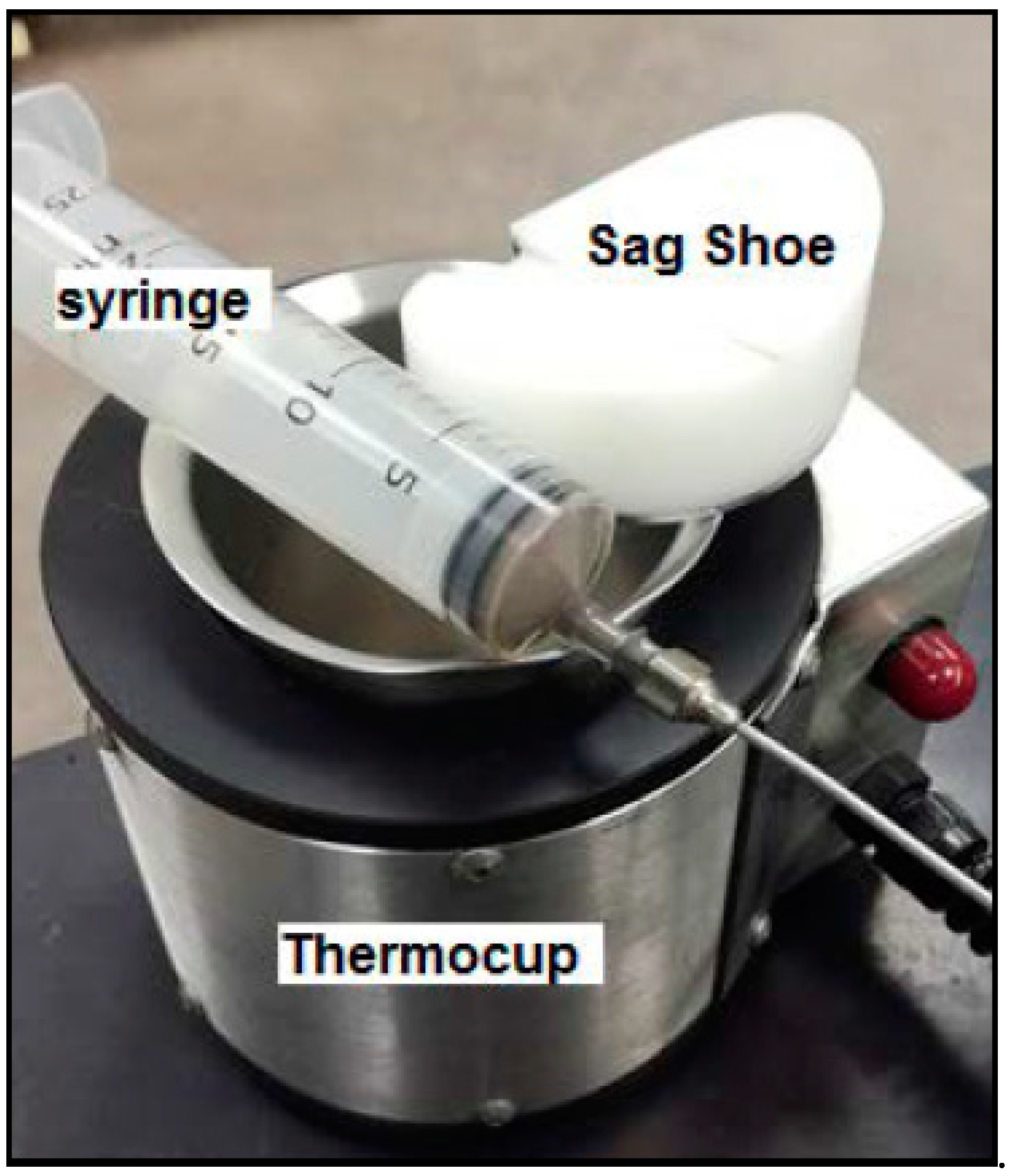

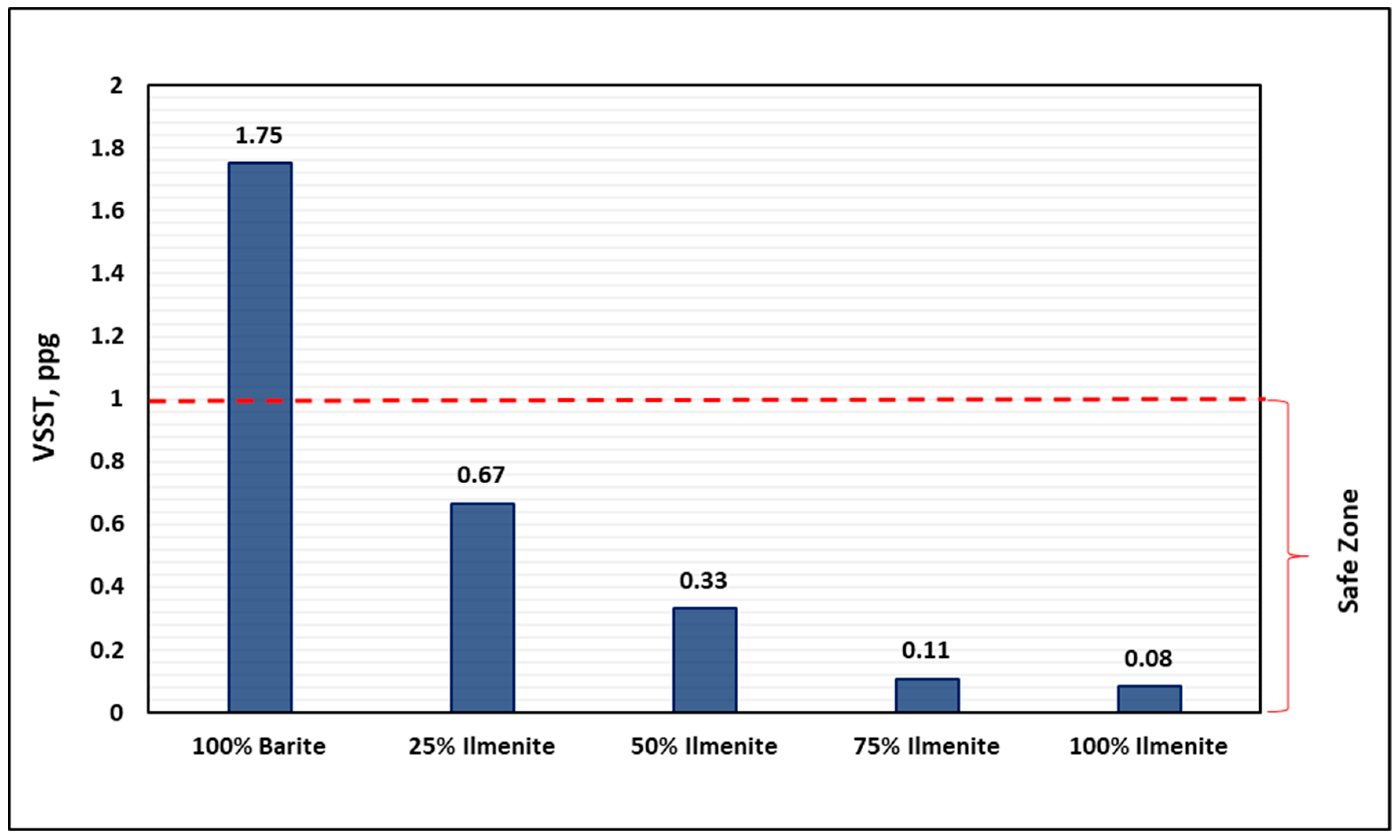
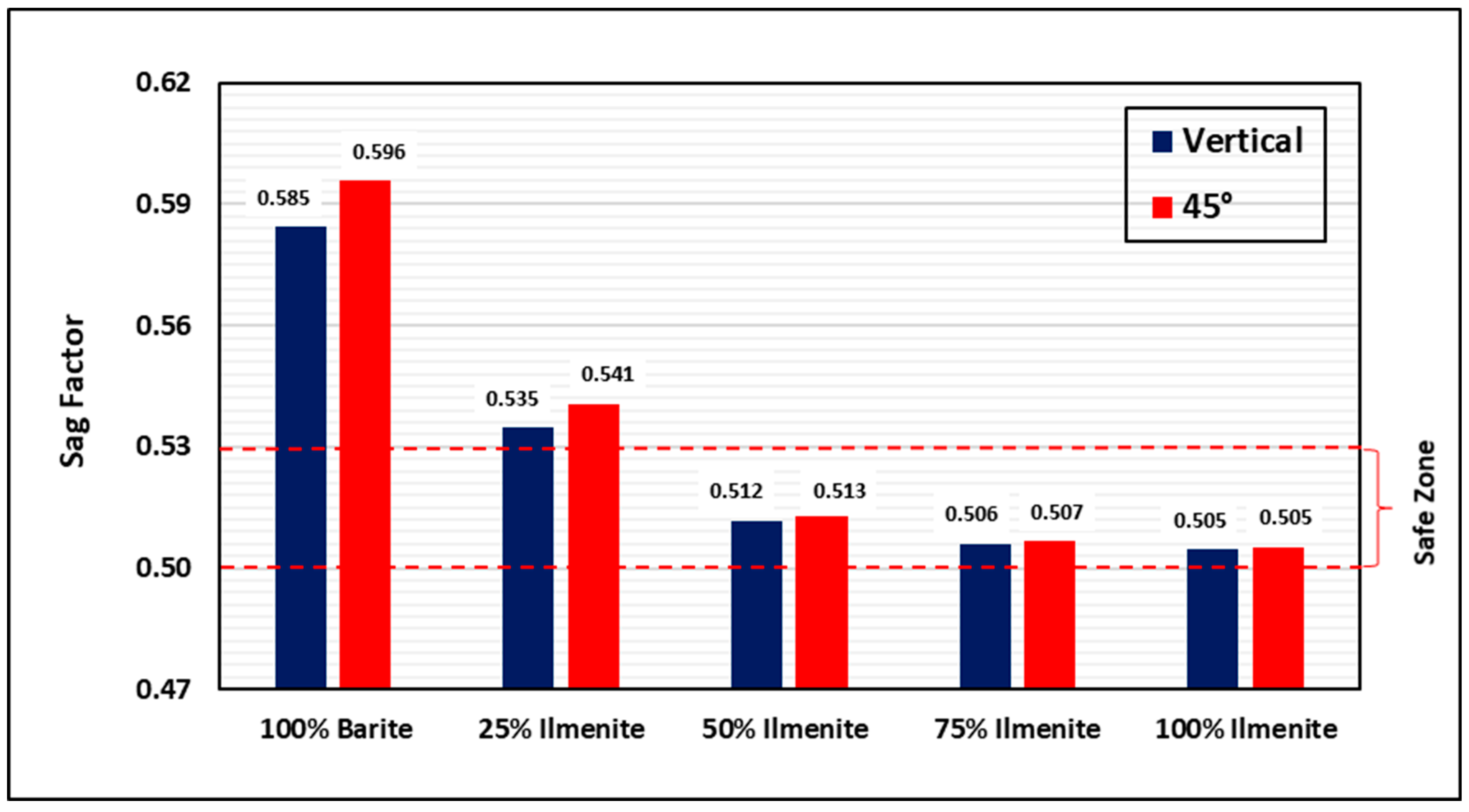
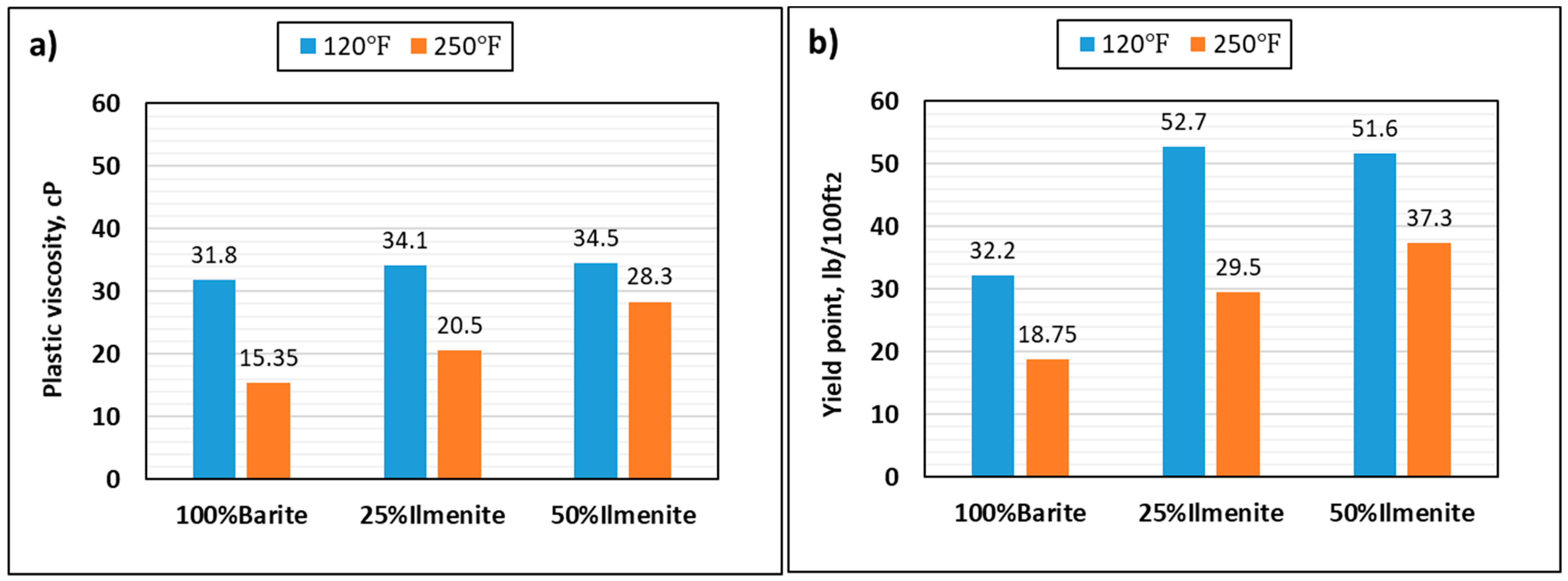
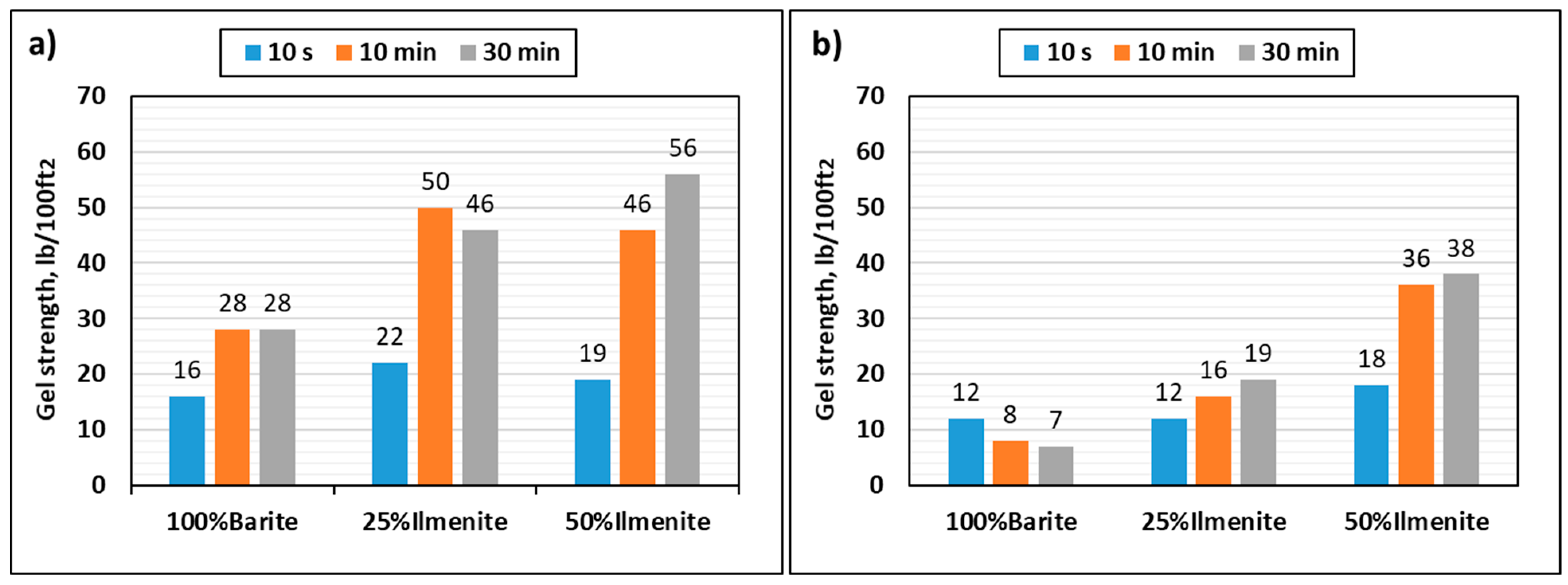
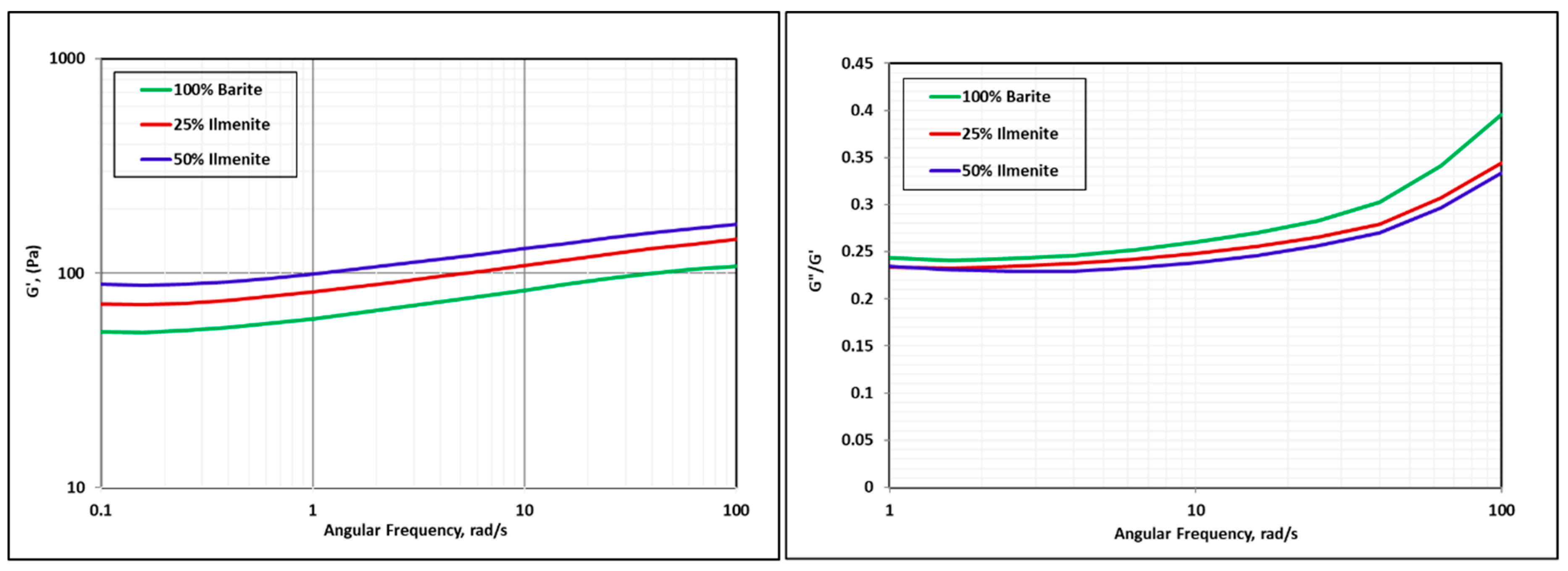
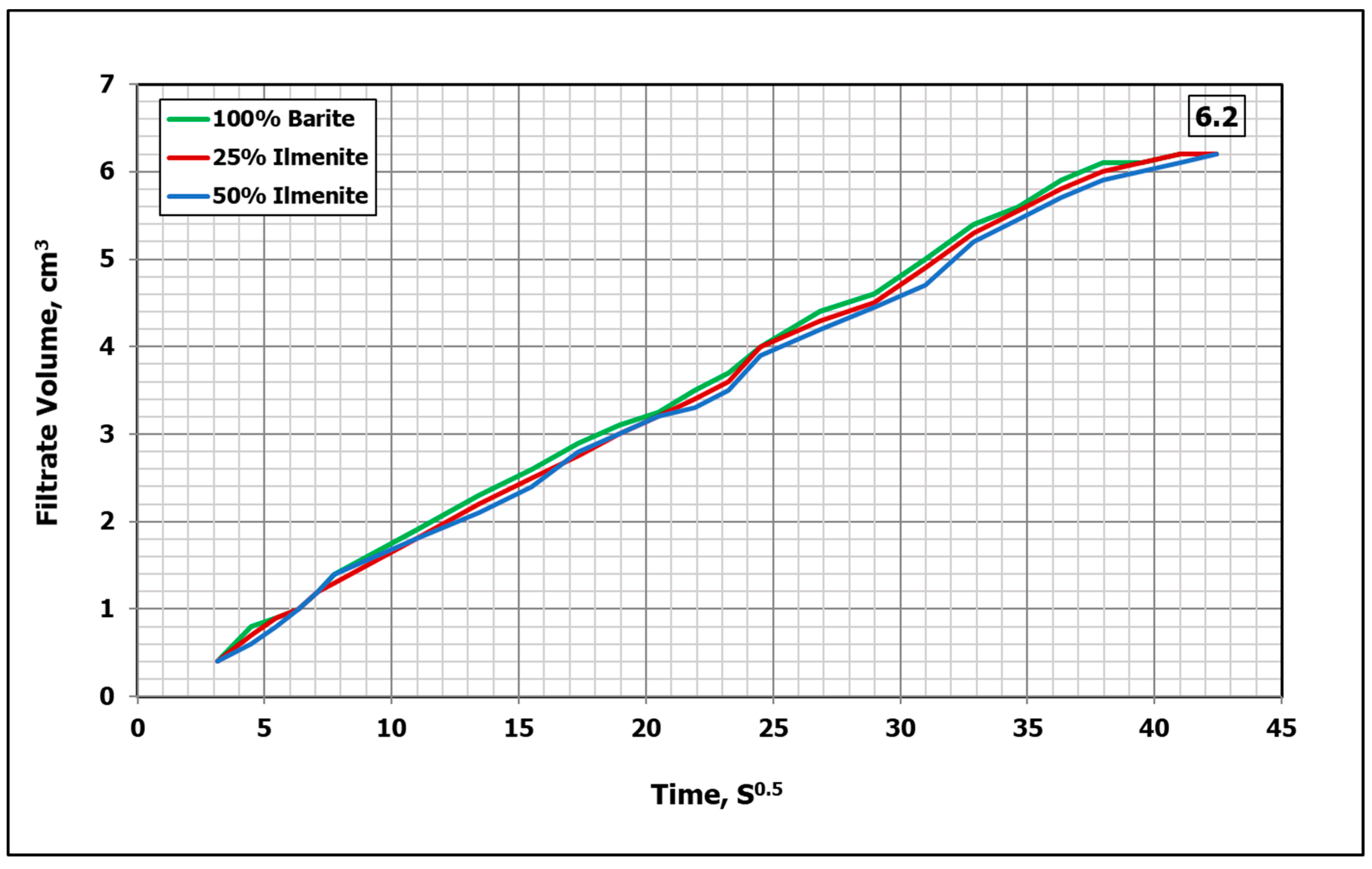

| Component | Amount (g) | Mixing Time (min) | Function |
|---|---|---|---|
| Water | 245 | - | Base fluid |
| Defoamer | 0.08 | 1 | Anti-foam agent |
| Soda ash | 0.5 | 1 | Maintain calcium concentration |
| XC-polymer | 1.5 | 20 | Viscosity control |
| Bentonite | 4 | 10 | Viscosity control |
| Potassium hydroxide | 0.5 | 1 | pH adjustment |
| Starch | 6 | 10 | Fluid loss control |
| PAC-R | 1 | 10 | Fluid loss control |
| Potassium chloride | 20 | 10 | Clay stabilization |
| Calcium carbonate | 5 | 10 | Bridging agent |
| Barite | 350 | 10 | Weighting material |
| Shear Rate (RPM) | Shear Stress (D.R.) | |
|---|---|---|
| 600 | 95.8 | |
| 300 | 64 | |
| 200 | 52.5 | |
| 100 | 38.3 | |
| 6 | 17.9 | |
| 3 | 17.2 | |
| Density | 15 | ppg |
| PV | 31.8 | cP |
| YP | 32.2 | lb/100 ft2 |
| Gel strength 10 s | 16 | lb/100 ft2 |
| Gel strength 10/30 min | 28/28 | lb/100 ft2 |
| Static Sag Test | Dynamic Sag Test | ||
|---|---|---|---|
| Temperature | 250 °F | Temperature | 120 °F |
| Pressure | 500 psi | Pressure | Atmospheric pressure |
| Time | 24 h | Time | 30 min |
| Inclination | Vertical (45°) | ||
| Parameter | Description |
|---|---|
| Condition | Static |
| Differential pressure | 300 psi |
| Temperature | 250 °F |
| Time | 30 min |
| Filtration medium | 10-μm ceramic filter disc |
| Parameter | 100% Barite | 25% Ilmenite | 50% Ilmenite |
|---|---|---|---|
| Filtrate volume (cm3) | 6.2 | 6.2 | 6.2 |
| Filter cake thickness (mm) | 2.59 | 2.56 | 2.51 |
| Filter cake weight (g) | 23 | 21.4 | 19.92 |
© 2019 by the authors. Licensee MDPI, Basel, Switzerland. This article is an open access article distributed under the terms and conditions of the Creative Commons Attribution (CC BY) license (http://creativecommons.org/licenses/by/4.0/).
Share and Cite
Basfar, S.; Mohamed, A.; Elkatatny, S.; Al-Majed, A. A Combined Barite–Ilmenite Weighting Material to Prevent Barite Sag in Water-Based Drilling Fluid. Materials 2019, 12, 1945. https://doi.org/10.3390/ma12121945
Basfar S, Mohamed A, Elkatatny S, Al-Majed A. A Combined Barite–Ilmenite Weighting Material to Prevent Barite Sag in Water-Based Drilling Fluid. Materials. 2019; 12(12):1945. https://doi.org/10.3390/ma12121945
Chicago/Turabian StyleBasfar, Salem, Abdelmjeed Mohamed, Salaheldin Elkatatny, and Abdulaziz Al-Majed. 2019. "A Combined Barite–Ilmenite Weighting Material to Prevent Barite Sag in Water-Based Drilling Fluid" Materials 12, no. 12: 1945. https://doi.org/10.3390/ma12121945






